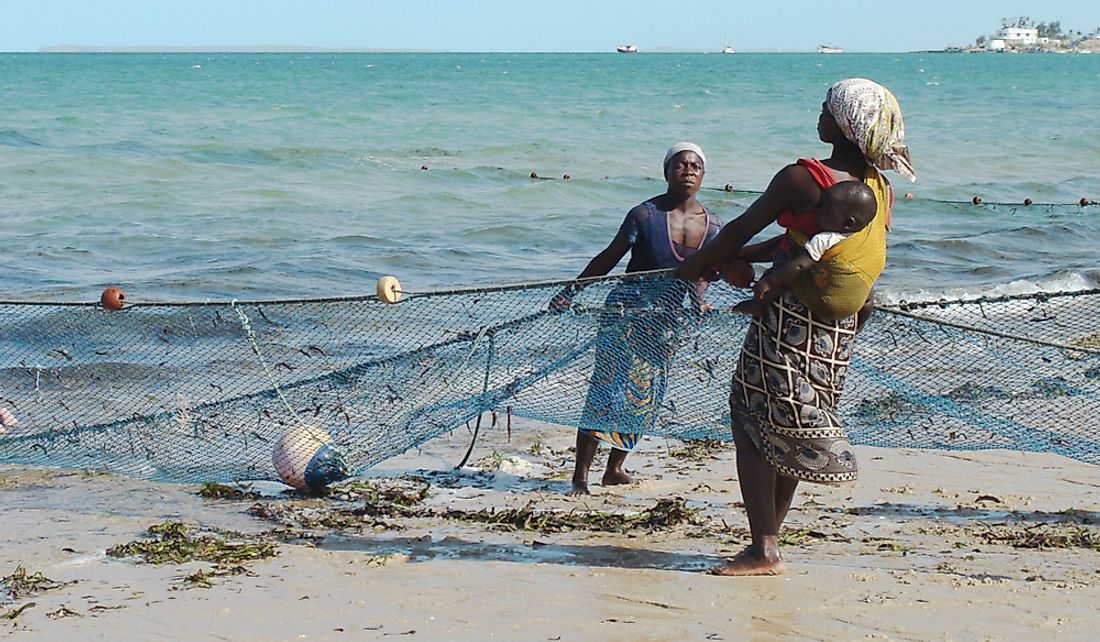The Culture Of Mozambique

The Southeast African nation of Mozambique has a culture that is a blend of the cultures of its various indigenous ethnic groups. The Portuguese colonial rule in the country has also heavily the nation's culture.
Ethnicity, Language, and Religion in Mozambique
Mozambique is home to a population of around 27,233,789 individuals. A large number of ethnic communities like the Makhuwa, Tsonga, Lomwe, and others reside in the country. 99.66% of Mozambique’s population comprises of native Africans. Europeans, Euro-Africans, and Indians constitute 0.06%, 0.2%, and 0.08% of the country’s population, respectively. Portuguese is the official language of Mozambique but it is spoken by only 10.7% of the population. Emakhuwa, Xichangana, Cisena, Elomwe, and Echuwabo are some of the most spoken Mozambican languages. Roman Catholicism is the religion of 30.3% of the country’s population. Protestant Christians, Zionist Christians, and Evangelical/Pentecostal Christians account for 19.2%, 10.6%, and 9.3% of Mozambique’s population, respectively.
Mozambican Cuisine
The cuisine of the country is rich and diverse. It is influenced by both indigenous and foreign cultures. Rice or steamed cornmeal is usually consumed with spicy vegetable or meat stews. Fish is also an important part of the Mozambican diet. Seafood dishes of the country include crayfish, prawns, etc., combined with the spicy Piri-Piri sauce. The Matapa is a typical Mozambican dish that is prepared using cassava leaves, shrimp, crab, coconut milk, and cashews. Piri piri chicken is also a popular dish. It is basically grilled chicken prepared in piri piri sauce and served with fries. A number of fruits are also consumed by the people.
Literature, Arts, and Craft in Mozambique
Although Mozambique has limited written literature, it has a rich heritage of oral literature. Storytelling is an important tradition in the country. Written literary works began to be produced in Mozambique with the spread of formal education during the Portuguese colonial period. However, since most of the literary works created during this time were associated with resistance to Portuguese colonialism, it was largely censored. Many writers like Bernardo Honwana were even imprisoned for their work. Today, written literary works in Mozambique cover a variety of styles and are mainly written in Portuguese. However, the literary scene in the country is still not well developed due to widespread poverty and low literacy levels.
Folk art of the Mozambicans represent the indigenous cultural beliefs of the country. During the colonial period, art in Mozambique reflected the oppression of the people by the colonial power. Modern art flourished in the country following independence. Besides art, the Mozambicans are also experts in a wide variety of crafts. For example, the Makonde people of Mozambique are well-known for their expertise in wood carving. They also produce elaborate masks that are used in ritual dances.
Performance Arts in Mozambique
The music of Mozambique ranges from folk music to modern pop and rock. The music is used to serve many purposes from pure entertainment to traditional and religious purposes. Drums made of animal skin and wood are commonly used to play traditional music. The marimba (a kind of xylophone) and the lupembe (a woodwind instrument made of wood or animal horns) are some other native Mozambican music instruments. The country also has different kinds of dances that vary from tribe to tribe. The Chopi people of country wear animal skins and act out battles. The Makua people dance on stilts around the village. Tufo is another traditional dance performed by women in Mozambique’s northern part. It is used to celebrate Islamic holidays.
Sports in Mozambique
Football (soccer) is the most popular sport in Mozambique. It is played both professionally and informally throughout the nation. The national football team of the country has participated in several Africa Cup of Nations tournaments. Estádio do Zimpeto in Maputo serves as the home ground of this team. Other sports like basketball, handball, roller hockey, futsal, and cricket are also played in Mozambique. The country has national teams in all these games.
Life in the Mozambican Society
Although the constitution of the nation grants equal rights to men and women, in practice this equality is hardly visible. Gender-based roles are clearly defined in the Mozambican society. While men are regarded as the breadwinners, women are expected to manage household chores and engage in childcare. Although women in the rural areas participate in agricultural activities, they are still regarded as subordinate to men and get lower wages than them. Women in urban areas are mostly confined to the home. Although times are changing, Mozambican women still have a long way to go before they are regarded as equal to men in society.
Marriages in Mozambique are based both on the consensual choice of the couple or are arranged by the parents of the couple. Polygamy was quite popular in the country until recently. Household units are quite large with several generations living together under one roof. Inheritance is both matrilineal and patrilineal in nature depending on the ethnic group involved.
Children are highly valued and the entire community engages in teaching social values to the children. They are taught to obey their elders and often start working at an early age. The civil war has left many children homeless and without their families. These children can be spotted in the big cities making a living out of stealing or selling small items on the street. Efforts are being made by the government and relief organizations to alleviate the problems of these children.











